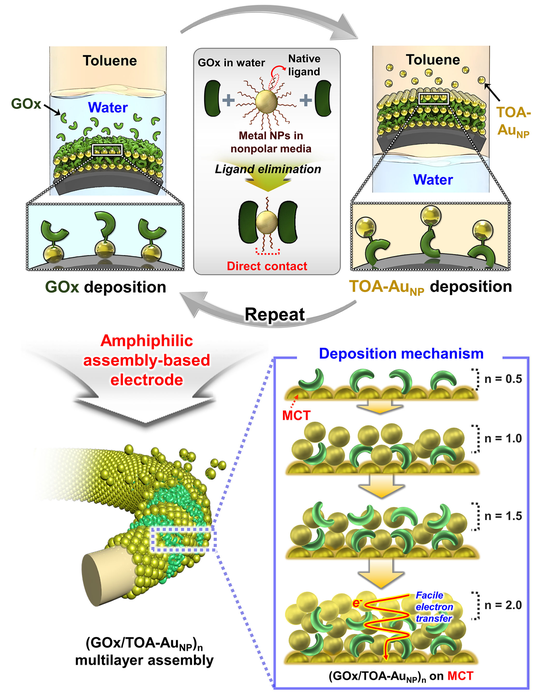Enzyme electrodes are used in numerous applications, such as electrochemical devices and biosensing systems, and biofuel cells (BFCs) are potential candidates for powering a range of bioelectronic devices by transforming biochemical energy into electricity under mild biological conditions.
 Amphiphilic assembly-based electrode for high-performance hybrid biofuel cells. Image Credit: Jinhan Cho.
Amphiphilic assembly-based electrode for high-performance hybrid biofuel cells. Image Credit: Jinhan Cho.
Regardless of their characteristics, the majority of current biofuel cells offer short-term operational stability and low power output as a result of their poor electron transfer between enzymes and electrodes and also between neighboring enzymes.
Such problems of electron transfer are directly linked to the performance of nearly all electrochemical sensors, such as BFCs and other bioelectronics.
In the journal Applied Physics Reviews, by AIP Publishing, researchers from Korea and the United States fulfill these shortcomings through an amphiphilic assembly that has been developed to make high-performance biofuel cells.
The method, which has the potential to induce favorable interfacial interactions between electrocatalysts and considerably enhance the electron transfer kinetics of electrodes, produced hybrid biofuel cells with good operational stability and high-power output.
Our novel electrode design using an amphiphilic assembly, which breaks with the common perspective of enzyme immobilization, can maximize the electron transfer at the enzyme/enzyme and enzyme/electrode interfaces as well as realize high operational stability, inducing the formation of a perfect and nanoblended enzyme layer.
Cheong Hoon Kwon, Study Author, Korea University
The technique induced favorable interfacial interactions between electrocatalysts and enhanced electron transfer kinetics of electrodes. It obtained unparalleled mass loading of hydrophilic enzyme and hydrophobic or conductive metal nanoparticles and significantly increased current density and electron transfer efficiency.
Amphiphilic assembled multilayers made of glucose oxidases in aqueous media and hydrophobic or conductive nanoparticles in nonpolar media. These particles were deposited onto cotton fiber or textile to form the anode, which has remarkably increased immobilization stability and electron transfer efficiency.
The cathode was developed by sputtering platinum onto the gold nanoparticle-coated cotton fibrils to enhance the efficiency of the oxygen reduction reaction.
The scientists believe the assembly technique might offer a basis for preparing a range of high-performance electrochemical devices, such as biofuel cells.
Our results could be of significant interest to various researchers and engineers working in the areas of self-assembly, energy conversion, and electrochemical sensors, in addition to BFCs.
Jinhan Cho, Study Co-Author, Korea University
The study has been co-authored by the authors Cheong Hoon Kwon, Minchul Kang, Minseong Kwon, Donghyeon Nam, Yongkwon Song, Euiju Yong, Min-Kyu Oh, Yongju Kim, Bongjun Yeom, Jun Hyuk Moon, Seung Woo Lee, and Jinhan Cho.
Journal Reference:
Kwon, C. H., et al. (2022) High-performance hybrid biofuel cells using amphiphilic assembly based enzyme electrodes. Applied Physics Reviews. doi.org/10.1063/5.0084917.